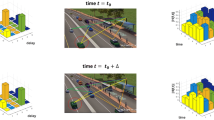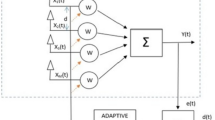Abstract
The coefficients of a Linear Minimum Mean Square Error (LMMSE) equalizer for a stationary random signal are defined by a Toeplitz system. The Toeplitz structure can be exploited to reduce computational complexity. In this paper we investigate the Levinson and Schur algorithm, as well as circulant embedding and circulant approximation methods applied to the Preconditioned Conjugate Gradient (PCG) method and Frequency Domain Equalization (FDE). We develop a novel circulant approximation method which improves the performance/complexity tradeoff. We show that the optimal choice of algorithms largely depends on the antenna configuration. Investigated configurations are Single Input Single Output (SISO), Single Input Multiple Output (SIMO) and Multiple Input Multiple Output (MIMO). All considered algorithms are benchmarked in terms of implementation complexity and capacity achieved by a High Speed Downlink Packet Access (HSDPA) receiver in a multipath fading scenario.




Similar content being viewed by others
Notes
The algorithm in [4] contains typos.
References
Guo, Y., Zhang, J., McCain, D., & Cavallaro, J. R. (2004). Efficient MIMO equalization for downlink multi-code CDMA: Complexity optimization and comparative study. In Proc. IEEE global communications conference (pp. 2513–2519).
Kay, S. M. (1993). Fundamentals of statistical signal processing. Englewood Cliffs, New Jersey: Prentice Hall.
Golub, G. H., & van Loan, C. F. (1996). Matrix computations (3rd ed.). Baltimore: The Johns Hopkins University Press.
Vollmer, M., Haardt, M., & Götze, J. (2001). Comparative study of joint-detection techniques for TD-CDMA based mobile radio systems. IEEE Journal on Selected Areas in Communications, 19(8), 1461–1474.
Sayed, A. H., & Kailath, T. (1995). A look-ahead block schur algorithm for Toeplitz-like matrices. SIAM Journal on Matrix Analysis and Applications, 16(2), 388–414.
Gallivan, K. A., Thirumalai, S., van Dooren, P., & Vermaut, V. (1996). High performance algorithms for Toeplitz and block Toeplitz matrices. Linear Algebra and Its Applications, 241–243, 343–388.
Huckle, T. K. (1994). Implementation of a superfast algorithm for symmetric positive definite linear equations of displacement rank 2. In Proc. SPIE (Vol. 2296, pp. 494–503).
Huckle, T. (1994). Iterative methods for Toeplitz-like matrices. Tech. Rep., Manuscript SCCM–94–05, Scientific Computing and Computational Mathematics Program.
Chan, R. H., & Ng, M. K. (1996). Conjugate gradient methods for Toeplitz systems. SIAM Review, 38(3), 427–482.
Shewchuk, J. R. (1994). An introduction to the conjugate gradient method without the agonizing pain. http://www.cs.cmu.edu/ quake-papers/painless-conjugate-gradient.pdf.
Chowdhury, S., & Zoltowski, M. D. (2001). Application of conjugate gradient methods in MMSE equalization for the forward link of DS-CDMA. In Proc. IEEE vehicular technology conference (Vol. 4, pp. 2434–2438).
Strang, G. (1986). A proposal for Toeplitz matrix calculations. Stud Appl Math, 74(2), 171–176.
Buchacher, C., Wehinger, J., & Huemer, M. (2009). Iterative versus adaptive equalizers in time-variant channels. In Proc. of IEEE global communications conference. Hawaii, USA.
O’Leary, D. (1980). The block conjugate gradient algorithm and related methods. Linear Algebra and Its Applications, 29, 293–322.
3rd Generation Partnership Project (2008). Technical specification 25.101; user equipment (UE) radio transmission and reception (FDD), v8.2.0, release 8. http://www.3gpp.org/.
ten Brink, S. (2001). Exploiting the chain rule of mutual information for the design of iterative decoding schemes. In Proc. IEEE Allerton conference.
Author information
Authors and Affiliations
Corresponding author
Additional information
This paper was presented in part at the IEEE Workshop on Signal Processing Systems (SiPS 2009).
Rights and permissions
About this article
Cite this article
Buchacher, C., Wehinger, J. & Huemer, M. A Novel Circulant Approximation Method for Frequency Domain LMMSE Equalization. J Sign Process Syst 64, 31–40 (2011). https://doi.org/10.1007/s11265-010-0484-7
Received:
Revised:
Accepted:
Published:
Issue Date:
DOI: https://doi.org/10.1007/s11265-010-0484-7




